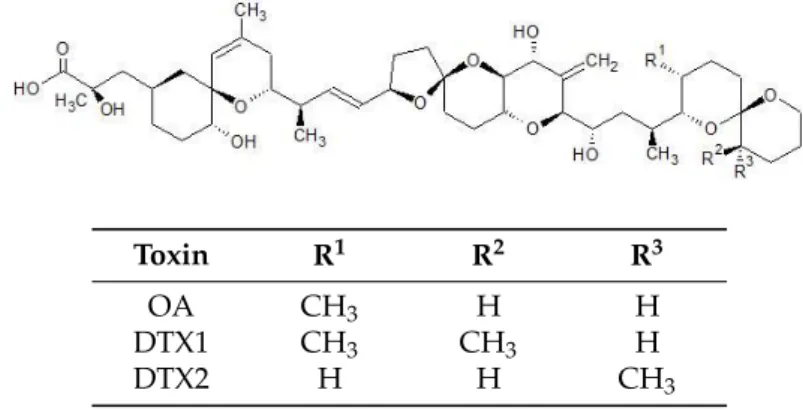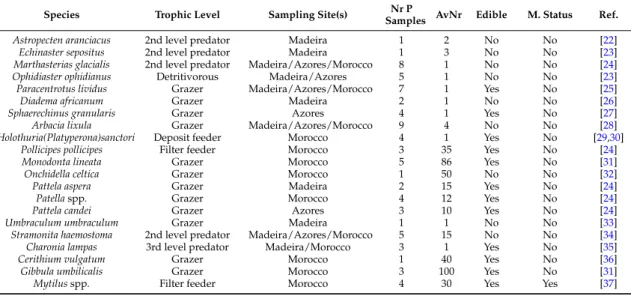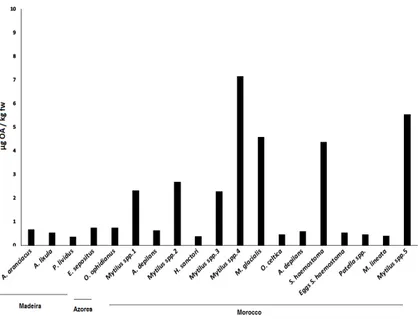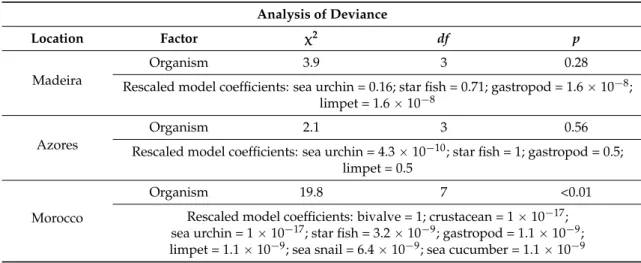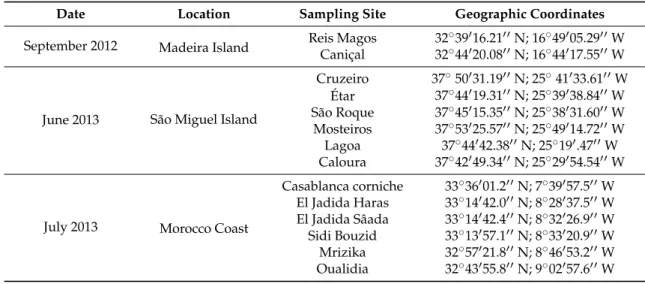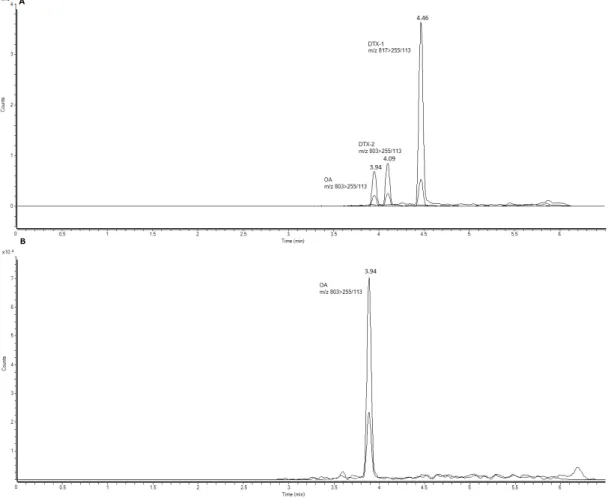New Invertebrate Vectors of Okadaic Acid from the
North Atlantic Waters—Portugal (Azores and
Madeira) and Morocco
Marisa Silva1,2, Inés Rodriguez3, Aldo Barreiro1,2, Manfred Kaufmann2,4,5, Ana Isabel Neto2,6, Meryem Hassouani7, Brahim Sabour7, Amparo Alfonso3, Luis M. Botana3and
Vitor Vasconcelos1,2,*
Received: 6 September 2015; Accepted: 16 November 2015; Published: 8 December 2015 Academic Editor: Irina Vetter
1 Department of Biology, Faculty of Sciences, University of Porto, Rua do Campo Alegre, 4619-007 Porto,
Portugal; marisasilva17@gmail.com (M.S.); aldo.barreiro@gmail.com (A.B.)
2 Interdisciplinary Center of Marine and Environmental Research–CIMAR/CIIMAR, University of Porto,
Rua dos Bragas 289, 4050-123 Porto, Portugal; mkaufmann@ciimar.up.pt (M.K.); aneto@uac.pt (A.I.N.)
3 Department of Pharmacology, Faculty of Veterinary, University of Santiago of Compostela, 27002 Lugo,
Spain; ines.rodriguez.filgueiras@usc.es (I.R.); amparo.alfonso@usc.es (A.A.); Luis.Botana@usc.es (L.M.B.)
4 University of Madeira, Marine Biology Station of Funchal, 9000-107 Funchal, Madeira Island, Portugal 5 Center of Interdisciplinary Marine and Environmental Research of Madeira—CIIMAR-Madeira,
Edifício Madeira Tecnopolo, Caminho da Penteada, 9020-105 Funchal, Madeira, Portugal
6 Department of Marine Biology, University of Azores, 9501-801 Ponta Delgada, Azores, Portugal 7 Phycology Research Unit—Biotechnology, Ecosystems Ecology and Valorization Laboratory,
Faculty of Sciences El Jadida, University Chouaib Doukkali, BP20 El Jadida, Morocco; hassouani@hotmail.com (M.H.); sabour.b@ucd.ac.ma (B.S.)
* Correspondence: vmvascon@fc.up.pt; Tel.: +351-223-401-814; Fax: +351-223-390-608
Abstract: Okadaic acid and its analogues are potent phosphatase inhibitors that cause Diarrheic Shellfish Poisoning (DSP) through the ingestion of contaminated shellfish by humans. This group of toxins is transmitted worldwide but the number of poisoning incidents has declined over the last 20 years due to legislation and monitoring programs that were implemented for bivalves. In the summer of 2012 and 2013, we collected a total of 101 samples of 22 different species that were made up of benthic and subtidal organisms such echinoderms, crustaceans, bivalves and gastropods from Madeira, São Miguel Island (Azores archipelago) and the northwestern coast of Morocco. The samples were analyzed by UPLC-MS/MS. Our main objective was to detect new vectors for these biotoxins. We can report nine new vectors for these toxins in the North Atlantic: Astropecten aranciacus,Arbacia lixula,Echinaster sepositus,Holothuria sanctori,Ophidiaster ophidianus, Onchidella celtica, Aplysia depilans, Patella spp., and Stramonita haemostoma. Differences in toxin contents among the species were found. Even though low concentrations were detected, the levels of toxins that were present, especially in edible species, indicate the importance of these types of studies. Routine monitoring should be extended to comprise a wider number of vectors other than for bivalves of okadaic acid and its analogues.
Keywords:okadaic acid; new vectors; Madeira Island; São Miguel Island; Morocco
1. Introduction
Toxins2015,7, 5337–5347
first isolated from two sponge species: Halichondria okadai and H. melanodocia [1,2], and are mainly produced by dynoflagellates of the generaDynophysis, Phalacroma, and Prorocentrum[3–5]. Regarding the mechanism of action, these toxins are strong inhibitors of serine/threonine phosphatases, especially types 1 and 2A with a particularly high affinity to 2A [6,7]. This inhibition results in the increase of the phosphorylation of a number of proteins leading to significant cell alterations, being OA and DTX1,which were also reported as tumor promotors and inducers of genotoxicity and cytotoxicity at low concentrations in marine invertebrates [8,9].
–
Toxin R1 R2 R3
OA CH3 H H
DTX1 CH3 CH3 H
DTX2 H H CH3
Figure 1.Chemical structures of OA, DTX1&2.
Although first reported in Japan, poisoning incidents occur all over the world and the most common route of intoxication is via ingestion of contaminated fish and shellfish [10–13]. These phycotoxins are heat and frost resistant and the taste and odor of the contaminated organisms remain unchanged [14–16]. DSP is known for its serious gastrointestinal symptoms, from chills to diarrhea, and the severity of the intoxication depends on the amount of toxin that the patient was exposed to [17].
Given their global incidence, DSTs are regulated worldwide. Studies on mice, together with epidemiologic studies, led to the establishment of the Lowest Observed Effect Level (LOEL) of 50 µg
OA equivalents/person [18]. Currently, the toxic equivalent factors (TEF) have been established, (Table1), and the limit value for the European Union is 160µg OA equivalents/ kg shellfish meat
(SM) [18,19]. Regarding detection methods, the European Food Safety Agency (EFSA) recommends the use of analytical techniques such as LC-MS/MS [18]. This recommendation was later reinforced in 2011 by the European Commission (EC) suggesting that this technique should be established as a reference method for DST detection by 31 December 2014 [20]. Analytical procedures are more reliable, do not have the ethical issues that come with the use of mice bioassay (MBA) technique, are able to identify several toxins in a mixture with high degree of sensitivity.
Table 1.Toxic equivalent factors for OA and its analogs.
Toxin TEF Reference
OA 1 [18]
DTX1 1 [18]
DTX2 0.6 [18]
Prior research demonstrated that DSTs can be found in unusual vectors along the food chain, although monitoring for this group of toxins, exclusively in bivalves, is simplistic and underestimates the risk to public health [21]. This argument is reinforced by the evidence that OA is bioaccumulated through the food web [21]. In this study, we surveyed the Portuguese islands of Madeira (Madeira archipelago) and São Miguel (Azores archipelago), and the northwestern coast of Morocco for new vectors through intertidal and SCUBA diving harvesting. We collected 22 species of benthic
organisms including gastropods (sea-snails, sea-slugs, and limpets), bivalves (mussels), crustaceans (barnacles), and echinoderms (starfishes, sea-urchins, and sea-cucumbers). The fact that most of the above-mentioned species are edible and commercially important species was a determining factor in the selection of these species (Table2). Inedible species were also sampled for their importance in the food chain. We believe that our data contribute to the development and updating of legislation regarding the monitoring procedures of these toxins in order to better protect public health.
Table 2.Species sampled and their trophic level, average number of specimens comprising a pooled sample (AvNr), and number of samples collected (NrP Samples)—from Madeira in September 2012, São Miguel Island, Azores, in June 2013, and Morocco in July 2013— edibility and monitoring status (M. status). Availability of animals is dependent on their geographical distribution and ecology.
Species Trophic Level Sampling Site(s) Nr P
Samples AvNr Edible M. Status Ref.
Astropecten aranciacus 2nd level predator Madeira 1 2 No No [22]
Echinaster sepositus 2nd level predator Madeira 1 3 No No [23]
Marthasterias glacialis 2nd level predator Madeira/Azores/Morocco 8 1 No No [24]
Ophidiaster ophidianus Detritivorous Madeira/Azores 5 1 No No [23]
Paracentrotus lividus Grazer Madeira/Azores/Morocco 7 1 Yes No [25]
Diadema africanum Grazer Madeira 2 1 No No [26]
Sphaerechinus granularis Grazer Azores 4 1 Yes No [27]
Arbacia lixula Grazer Madeira/Azores/Morocco 9 4 No No [28]
Holothuria(Platyperona)sanctori Deposit feeder Morocco 4 1 Yes No [29,30]
Pollicipes pollicipes Filter feeder Morocco 3 35 Yes No [24]
Monodonta lineata Grazer Morocco 5 86 Yes No [31]
Onchidella celtica Grazer Morocco 1 50 No No [32]
Pattela aspera Grazer Madeira 2 15 Yes No [24]
Patellaspp. Grazer Morocco 4 12 Yes No [24]
Pattela candei Grazer Azores 3 10 Yes No [24]
Umbraculum umbraculum Grazer Madeira 1 1 No No [33]
Stramonita haemostoma 2nd level predator Madeira/Azores/Morocco 5 15 No No [34]
Charonia lampas 3rd level predator Madeira/Morocco 3 1 Yes No [35]
Cerithium vulgatum Grazer Morocco 1 40 Yes No [36]
Gibbula umbilicalis Grazer Morocco 3 100 Yes No [31]
Mytilusspp. Filter feeder Morocco 4 30 Yes Yes [37]
2. Results and Discussion
In this study, a total of 101 samples were collected from three different sampling sites:
Madeira (25 samples) in September 2012, São Miguel Island, Azores (37 samples), in June 2013 and the northwestern coast of Morocco (39 samples) in July 2013 (Figure2).
Several species belonging to distinct taxa were collected, comprising starfish (A. aranciacus, E. sepositus,M. glacialis,O. ophidianus), sea-urchins (A. lixula,D. africanum,P. lividus,S. granularis), sea-cucumber (H. sanctori), crustaceans (P. pollicipes), bivalves (Mytillus spp.) and gastropods (A. depilans,C. vulgatum,C. lampas,G. umbilicalis,M. lineata,O. celtica,Patellaspp.,P. candei,P. tenuis tenuis,P.aspera,S. haemostoma, andU. umbraculum).
OA and its analogues were screened in the three sampling sites. A total of 19% of the samples contained quantifiable OA contents for OA (above the limit of quantification (LOQ)), but neither DTX1 nor DTX2 were detected (Figure3). DTX3 was also screened in all of the samples but was below the limit of detection (LOD) of the equipment. The LOD and LOQ for AO/DTX1/DTX2 in our equipment were 0.468 ng/mL and 1.56 ng/mL, respectively. In order to analyze and quantify OA/DTX1/DTX2 in the samples, a 50ˆstep was added whereby the amounts of 1.85–35 ng/mL (0.37–7µg/Kg) were detected. Following the official control method of the European Union, alkaline
Toxins2015,7, 5337–5347
LOQ. No changes were observed in these peaks before and after hydrolysis. If the samples had been concentrated, the pH of the solution would have changed and the toxins could have degraded.
– –
Figure 2. Location of the sampling points: (A) the coast of São Miguel Island, Azores archipelago: 1-Cruzeiro; 2-Mosteiros; 3-Étar; 4-São Roque; 5-Lagoa; and 6-Caloura; (B) the coast of Madeira: 1-Reis Magos; 2-Caniçal; and (C) the northwestern coast of Morocco: 1-Casablanca Corniche; 2-El Jadida Haras; 3-El Jadida Sâada; 4-Sidi Bouzid; 5-Mrizika; and 6-Oualidia.
The majority of the samples with OA (73.7%), as well as the samples with the highest concentrations, were detected on the coast of Morocco, followed by Madeira (21.1%). This might be due to the fact that both sampling sites are at the same latitude. For São Miguel Island (Azores), only one measurable sample was detected in the starfishO. ophidianus.
— —
— — —
—
— —
model’s
“organism” did not turn out to be a significant factor, most likely due to the low number of samples with
The factor “organism” was significant both in Madeira
Figure 3.OA (µg/Kg fresh weight (fw)) for all sampled groups of organisms in Madeira (Starfish—A.
aranciacus,E. sepositus; Sea-urchins—A. lixula,P. lividus) Azores (Starfish—O. ophidianus) and Morocco (Starfish—M. glacialis; Sea-cucumbers—H. sanctori; Gastropods—A. depilans,O. celtica,S. haemostoma,
Patellaspp.,M. lineata; Bivalves-Mytilusspp.).Numbers correspond to different sampling locations in Morocco: 1-Casablanca Corniche; 2-Sidi Bouzid; 3-El Jadida Saâda; 4-Mrizika; and 5-Oualidia.
Average concentrations detected were all below the current limit implemented in the European legislation—160 µg OA equivalents/ kg shellfish meat [18]—and ranged from 0.368 µg/kg fresh
weigh (fw), inP. lividus, to 7.157µg/kg fw inMytilusspp.
Regarding statistics, the first step of the gamma hurdle model was a Generalized Linear Model (GLZ) performed with the data of presence/absence of OA, using binomial distribution error.
This model was applied separately to each geographical location. The results of the model’s analysis of deviance as well as the coefficients rescaled to a logistic probability [0,1] are shown in Table3. The “organism” did not turn out to be a significant factor, most likely due to the low number of samples with quantifiable OA contents, except in Morocco. In Morocco, the highest probability corresponded to the bivalve, whereas all other organisms had very low probabilities of containing OA. The second part of the model with the gamma error distribution analyzes the variation in OA concentration, showing quantifiable results among those samples. It was not possible to perform this analysis in Azores because there was only one single sample containing OA. The factor “organism” was significant both in Madeira and Morocco (Table4).In Madeira, OA only appeared in sea urchin and star fish, with star fish containing three times more OA, on average (1.58versus0.45, Table4). In Morocco, the bivalves contained much more OA than all the other organisms, the closest one being the sea star, with an average of approximately ¼ of bivalve OA content (4versus1.15, Table4).
Table 3.Results of the binomial regression model for OA occurrence with “organism” as a factor.
Analysis of Deviance
Location Factor χ2 df p
Madeira
Organism 3.9 3 0.28
Rescaled model coefficients: sea urchin = 0.16; star fish = 0.71; gastropod = 1.6ˆ10´8; limpet = 1.6ˆ10´8
Azores
Organism 2.1 3 0.56
Rescaled model coefficients: sea urchin = 4.3ˆ10´10; star fish = 1; gastropod = 0.5; limpet = 0.5
Morocco
Organism 19.8 7 <0.01
Rescaled model coefficients: bivalve = 1; crustacean = 1ˆ10´17; sea urchin = 1ˆ10´17; star fish = 3.2ˆ10´9; gastropod = 1.1ˆ10´9; limpet = 1.1ˆ10´9; sea snail = 6.4ˆ10´9; sea cucumber = 1.1ˆ10´9
Table 4.Results of the gamma regression model for OA occurrence with organism as factor.
Analysis of Deviance
Location Factor χ2 df p
Madeira Organism 5.4 1 <0.05
Rescaled model coefficients: sea urchin = 0.45; star fish = 1.58
Morocco
Organism 12.8 5 <0.05
Rescaled model coefficients: bivalve = 4; star fish = 1.15; gastropod = 0.44; limpet = 0.12; sea snail = 0.15; sea cucumber = 0.1
The high number of positive detections in Morocco could be explained by an increased eutrophication effect, due to larger population density, continental runoff, and industrial pollution. In comparison to the previous study, the amounts of OA detected are quite different, ranging from 0.58µg/Kg fw to 429.41µg/Kg fw [21], even though the number of screened species is higher in
Toxins2015,7, 5337–5347
statistical point of view, it is not possible to compare the bioaccumulation results between the studies due to the lower positive hits obtained in the present study.
Owing to the oligotrophic waters of Madeira and Azores archipelagos, bivalves are not common, which makes gastropods and echinoderms a good alternative for the monitoring of OA and its derivatives in both archipelagos.
We report nine new vectors for OA in the speciesA. aranciacus,A. lixula,A. depilans,E. sepositus, H. sanctori,O. celtica,O. ophidianus,Patellaspp., andS. haemostoma. We also detected OA in the eggs of S. haemostomaindicating a potential parental transfer of the toxin to the offspring. These kind of cases have already been reported, as an example inTakifugo rubripeslarvae that are protected by maternal tetrodotoxin [38].
3. Experimental Section
3.1. Selected Species and Sampling Sites
The coasts of the Portuguese islands of Madeira (Madeira archipelago), São Miguel (Azores archipelago), and the northwestern coast of Morocco, were surveyed for non-traditional vector species for Okadaic Acid and its analogs. These locations were chosen as a result of collaborations and projects with the local entities, who also allowed us to survey these areas.
Several edible and non-edible species were selected (n= 22) to search for potential new vectors and the prevalence of the screened biotoxins in the food web: gastropods (Patella tenuis tenuis, Patella aspera,Stramonita haemostoma,Umbraculum umbraculum,Charonia lampas,Patella candei,Patella spp., Aplysia depilans, Monodonta lineata, Cerithium vulgatum, Gibbula umbilicalis,Onchidellaceltica), crustaceans (Pollicipes pollicipes), bivalves (Mytillusspp.), starfish (Astropecten aranciacus,Ophidiaster ophidianus,Marthasterias glacialis,Echinaster sepositus), sea-cucumber (Holothuria (Platyperona) sanctori), and sea-urchins (Paracentrotus lividus, Arbacia lixula, Sphaerechinus granularis, Diadema africanum). Benthic organisms were harvested from the intertidal areas during low tide and by scuba diving expeditions: the island of Madeira was surveyed in September 2012, São Miguel Island, Azores, and the Moroccan coast were sampled in June and July 2013, respectively (sampling sites are displayed in Table 5). Two samples of Patella tenuis tenuis and P. aspera were purchased at local markets in Madeira, which were caught off the northern coast of the island (32˝51117.0211 N;
17˝01154.0211W). Sample identification was aided by the use of field guides. Organisms were
transported to the laboratory in refrigerated containers. Samples were frozen at´20˝C, if they were not processed immediately.
Table 5.Sampling sites and respective geographical coordinates, surveyed during September of 2012 and June and July of 2013.
Date Location Sampling Site Geographic Coordinates
September 2012 Madeira Island Reis MagosCaniçal 3232˝˝39441116.2120.081111N; 16N; 16˝˝44491117.5505.291111WW
June 2013 São Miguel Island
Cruzeiro 37˝50131.1911N; 25˝41133.6111W Étar 37˝44119.3111N; 25˝39138.8411W São Roque 37˝45115.3511N; 25˝38131.6011W Mosteiros 37˝53125.5711N; 25˝49114.7211W Lagoa 37˝44142.3811N; 25˝191.4711W Caloura 37˝42149.3411N; 25˝29154.5411W
July 2013 Morocco Coast
Casablanca corniche 33˝36101.211N; 7˝39157.511W El Jadida Haras 33˝14142.011N; 8˝28137.511W El Jadida Sâada 33˝14142.411N; 8˝32126.911W Sidi Bouzid 33˝13157.111N; 8˝33120.911W Mrizika 32˝57121.811N; 8˝46153.211W Oualidia 32˝43155.811N; 9˝02157.611W
3.2. Sample Extraction and Hydrolysis Procedure
The Otero et al. (2010) extraction protocol was followed [39]. The recuperation rate of the method was calculated with a 95% recovery of OA in mussels. In short, shells were removed when necessary and then animals were homogenized with a blender (A320R1, 700 W, Moulinex, Lisbon, Portugal) in pooled groups in order to obtain 1 g of tissue, with the exception ofOphidiaster ophidianus, Paracentrotus lividus,Sphaerechinus granularis,Umbraculum umbraculum,Diadema africanum,Holoturia (Platyperona) sanctori,Charonia lampas,Marthasterias glacialis, andAplysia depilans. In these cases, each animal was handled separately since they had enough extractable biomass, so we ended up with a single sample per organism/sampling site. 1 g Homogenized tissue was processed with 3 mL of methanol (Fisher Scientific, Porto Salvo, Portugal), and then centrifuged for 10 min at 2932 g at 4˝C
(Centrifugal-Legend RT, Waltham, USA). This procedure was repeated twice and the supernatants were combined and concentrated to dryness (Acid-resistant Centrivap Concentrator, Labconco, Kansas City, USA). Afterwards, residues were re-suspended in 10 mL of water (Milli-Q, Madrid, Spain) and doubly partitioned with dichloromethane (Merck, Darmstadt, Germany). Aqueous layer was discarded and the organic layers (20 mL) were concentrated by drying and re-suspended in 1 mL of methanol. After that, 500µL was concentrated to dryness, re-suspended in 100µL of methanol and
filtered through a 0.45µm filter (UltraFree-MC centrifugal devices, Millipore, Bedford, MA, USA).
In order to detect and quantify the total content of OA and DTXs, 20µL of methanolic extract were
brought to a final volume of 1 mL. This dilution was hydrolyzed with 125µL 2.5 M NaOH (Fluka,
Sigma-Aldrich, Madrid, Spain), the mixture was homogenized and heated at 76˝C for 40 min. and
then cooled to room temperature, neutralized with 125µL 2.5 M HCl (Panreac, Barcelona, Spain) and
homogenized in the vortex [40]. The extract was filtered with 0.45µm filter and injected 5µL in the
LC column.
3.3. Sample Analysis
Analyses were performed using a 1290 Infinity ultra-high-performance liquid chromatography system coupled to a 6460 Triple Quadrupole mass spectrometer (Agilent Technologies, Waldbronn, Germany). Toxin separation was performed with an AQUITY UPLC BEH C18 column (2.1ˆ100 mm, 1.7µm, Waters, Manchester, UK). Column oven was set at 40˝C, samples in the autosampler were
cooled to 4˝C and injection volume was 5µL. Eluent A consisted of 100% water and B acetonitrile
(Panreac Quimica, Barcelona, Spain) in water (95:5), both containing 50 mM formic acid (Merck, Madrid, Spain) and 2 mM ammonium formate (Sigma Aldrich, Madrid, Spain). The gradient started with 30%–70% of mobile phase (B) for 3 min, then maintained in 70% B for 4.5 min and decreasing to 30% over 0.1 min and maintained during 1.99 min until the end of the run. Flow rate was 0.4 mL/min. MS detection was performed using an Agilent G6460C triple quadrupole mass spectrometer equipped with an Agilent Jet Stream ESI source (Agilent Technologies, Waldbronn, Germany). Source conditions were optimized to achieve the best sensitivity for all compounds. A drying gas temperature of 350˝C and a flow of 8 L/min, a nebulizer gas pressure of 45 psi (Nitrocraft NCLC/MS
from Air Liquid, Madrid Spain), a sheath gas temperature of 400˝C and a flow of 11 L/min were
Toxins2015,7, 5337–5347
were quantified, using their peak areas to calculate amounts and using the curve obtained from each standard. The LOD and LOQ for OA/DTX1/DTX2 were 0.0936 and 0.312µg/Kg, respectively.
Figure 4. Mass chromatograms of the UPLC-MS/MS obtained under multiple reaction monitoring (MRM) in negative mode. (A) Total ion chromatogram (TIC) of OA standard (100 ng/mL),
m/z803.5 > 255.2/113.2, DTX2 standard (100 ng/mL),m/z803.5 > 255.5/113.5 and DTX1 standard (100 ng/mL),m/z817.5 > 255.2/113. (B) TIC of a sample with quantifiable OA contents inMytillus
spp. (m/z803.5 > 255.5/113.5).
3.4. Statistical Analyses
The influence of the sampling site (Morocco, Madeira, and Azores islands) and organism type in the OA occurrence was analyzed using Generalized Linear Models (GLZ). The dependent variable was the concentration of OA in the organism’s flesh (µg¨kg´1). The organisms were grouped according to their most distinctive taxonomical degree, which was not necessarily species since, in some cases, very similar species were sampled at the same time. The levels of the factor organism were: bivalve, sea cucumber, sea urchin, sea star, sea snail, and limpet. The data set consisted of OA concentrations found in pooled samples from each organism. Each sample corresponds to a single organism or a pool of organisms, in order to make up for 1 g of extracting biomass (please see methods). The dataset could be considered as a zero (inflated dataset) with a variance larger than the mean. These models are usually handled with Poisson or negative binomial distributions [41]. However, neither of these distributions could be used because our data are continuous. Instead, we used the approach of the gamma hurdle models [42] which use two steps to make the analysis: firstly, analyzing the presence/absence of the toxin (managed with a binomial or negative binomial distribution) and secondly, in these data, showing measurable concentrations of OA, a GLZ with
gamma distribution. In addition to the analysis, including the “sampling site” and “organism” as factors, another analysis which only considers the “organism” as a factor was performed for which new organism levels that only occurred in a single sampling site were included: mussel, barnacle, sea cucumber, and sea hare. All the models were performed with R software [43], package stats function glm.
4. Conclusions
In this study, we used the UPLC-MS/MS technique for the screening of non-described vectors for Okadaic acid and its derivatives in the northwestern coast of Morocco, Madeira, and São Miguel Islands (Madeira and Azores archipelagos, respectively). We detected OA in a total of nine new vectors among the 22 screened species: echinoderms (A. aranciacus,A. lixula,E. sepositus,H. sanctori, O. ophidianus) and gastropods (O. celtica,A. depilans,Patellaspp., andS. haemostoma). We also detected OA in the eggs of S. haemostoma. Regarding species uptake, the organisms with a higher uptake tendency were mussels, followed by gastropods and echinoderms. Due to the scarcity of mussels in Madeira and Azores archipelagos, gastropods and echinoderms could be a good alternative for the monitoring of this group of toxins. Although the detected values are below the limit value currently implemented in the European Union, it is important to extend the monitored organisms beyond bivalves to learn more about the trophic transfer of these toxins and OA seasonal dynamics to better calculate human health risk in these poorly studied areas.
Acknowledgments: This research was partially funded by the FCT project UID/Multi/04423/2013 and by the projects MARBIOTECH (reference NORTE-07-0124-FEDER-000047) within the SR&TD Integrated Program MARVALOR—Building research and innovation capacity for improved management and valorization of marine resources, supported by the Programa Operacional Regional do Norte (ON.2-O Novo Norte) and NOVOMAR (reference 0687-NOVOMAR-1-P), supported by the European Regional Development Fund. MS acknowledge also FCT for the grant SFRH/BD/73269/2010 and Ana Regueiras, Isadora Diniz, Afonso Prestes and Manuela Maranhão. This research was also partially funded by the FCT-Portugal/CNRST-Morocco Cooperation Convention under the project 1006/13 CNR “Marine emergent toxins in the north east Atlantic (Portugal-Morocco) produced by microalgae and bacteria”. The research leading to USC results has received funding from the following FEDER cofunded-grants, from CDTI and Technological Funds. Supported by Ministerio de Economía y Competitividad, AGL2012-40185-CO2-01 and Consellería de Cultura, Educación e Ordenación Universitaria, GRC2013-016. Inés Rodriguez is supported by a fellowship from Subprograma de Formación de Personal Investigador (AGL2012-40185-CO2-01), Spain.
Author Contributions: M.S. and V.V. conceived the idea, M.S. performed the sampling, sample analyses and paper writing. I.R. and A.B. collaborated in sample analyses. A.A. contributed on experimental design. M.H. collaborated in sample collection. V.V. and L.M. contributed in funding, materials and analyses tools. V.V., B.S., A.I.N., M.K.: Collaborated in the collections and provided sampling and laboratory facilities. All: proof reading of the manuscript.
Conflict of Interest:The authors declare no conflict of interest.
References
1. Schmitz, F.J.; Prasad, R.S.; Gopichand, Y.; Hossain, H.B.; van der Helm, D.; Schmidt, P. Acanthifolicin, a new episufide-containing polyether carboxylic acid from extracts of the marine spongepandaros acanthifolium. J. Am. Chem. Soc.1981,103, 2467–2469. [CrossRef]
2. Tachibana, K.; Scheurrer, P.J.; Tsukitani, Y.; Kikuchi, H.; Engen, D.V.; Clardy, J.; Gopichand, Y.; Schimitz, F.J. Okadaic acid, a cytotoxicity polyether from two marine sponges of the genushalichondria.J. Am. Chem. Soc.
1981,103, 2469–2471. [CrossRef]
3. MacKenzie, L.; Beuzenberg, V.; Holland, P.; McNabb, P.; Suzuki, T.; Selwood, A. Pectenotoxin and okadaic acid-based toxin profiles in dinophysis acuta anddinophysis acuminatafrom new zealand. Harmful Algae
2005,4, 75–85. [CrossRef]
Toxins2015,7, 5337–5347
5. Caroppo, C.; Congestri, R.; Bruno, M. On the presence ofphalacroma rotundatumin the southern adriatic sea (Italy).Aquat. Microb. Ecol.1999,17, 301–310. [CrossRef]
6. Bialojan, C.; Takai, A. Inhibitory effect of a marine sponge toxin, okadaic acid, on protein phosphatases.
Biochem. J.1988,256, 283–290. [CrossRef] [PubMed]
7. Takai, A.; Murata, M.; Torigoe, K.; Isobe, M.; Mieskes, G.; Yasumoto, T. Inhibitory effect of okadaic acid derivatives on protein phosphatases. A study on structure-affinity relationship. Biochem. J. 1992, 284,
539–544. [CrossRef] [PubMed]
8. Maneiro, E.; Rodas, V.L.; Costas, E.; Hernandez, J.M. Shellfish consumption: A major risk factor for colorectal cancer.Med. Hypotheses2008,70, 409–412. [CrossRef] [PubMed]
9. Prego-Faraldo, M.V.; Valdiglesias, V.; Laffon, B.; Eirin-Lopez, J.M.; Mendez, J.In vitro analysis of early genotoxic and cytotoxic effects of okadaic acid in different cell types of the musselmytilus galloprovincialis. J. Toxicol. Environ. Health A2015,78, 814–824. [CrossRef] [PubMed]
10. Yasumoto, T.; Oshima, Y.; Yamaguchi, M. Occurrence of a new type of shellfish poisoning in tohoku district.
Bull. Jpn. Soc. Sci. Fish.1978,44, 1249–1255. [CrossRef]
11. Elgarch, A.; Vale, P.; Rifai, S.; Fassouane, A. Detection of diarrheic shellfish poisoning and azaspiracid toxins in moroccan mussels: Comparison of the LC-MS method with the commercial immunoassay kit.
Mar. Drugs2008,6, 587–594. [CrossRef] [PubMed]
12. Garcia, C.; Truan, D.; Lagos, M.; Santelices, J.P.; Diaz, J.C.; Lagos, N. Metabolic transformation of dinophysistoxin-3 into dinophysistoxin-1 causes human intoxication by consumption ofo-acyl-derivatives
dinophysistoxins contaminated shellfish.J. Toxicol. Sci.2005,30, 287–296. [CrossRef] [PubMed] 13. Scoging, A.; Bahl, M. Diarrhetic shellfish poisoning in the UK.Lancet1998,352, 117. [CrossRef]
14. Reboreda, A.; Lago, J.; Chapela, M.J.; Vieites, J.M.; Botana, L.M.; Alfonso, A.; Cabado, A.G. Decrease of marine toxin content in bivalves by industrial processes.Toxicon2010,55, 235–243. [CrossRef] [PubMed] 15. McCarron, P.; Kilcoyne, J.; Hess, P. Effects of cooking and heat treatment on concentration and tissue
distribution of okadaic acid and dinophysistoxin-2 in mussels (mytilus edulis).Toxicon2008,51, 1081–1089.
[CrossRef] [PubMed]
16. Lawrence, J.; Loreal, H.; Toyofuku, H.; Hess, P.; Karunasagar, I.; Ababouch, L.Assessment and Management of Biotoxin Risks in Bivalve Mollusks; FAO: Rome, Italy, 2011; p. 337.
17. Hamano, Y.; Kinoshita, Y.; Yasumoto, T. Enteropathogenicity of diarrheic shellfish toxins in intestinal models.J. Food Hyg. Soc. Jpn.1985,27, 375–379. [CrossRef]
18. Alexander, J.; Auðunsson, G.A.; Benford, D.; Cockburn, A.; Cravedi, J.P.; Dogliotti, E.; di Domenico, A.; Fernández-Cruz, M.L.; Fink-Gremmels, J.; Fürst, P.;et al. Opinion of the scientific panel on contaminants in the food chain on a request from the european commission on marine biotoxins in shellfish—Okadaic acid and analogues.EFSA J.2008,589, 1–62.
19. Aune, T.; Larsen, S.; Aasen, J.A.; Rehmann, N.; Satake, M.; Hess, P. Relative toxicity of dinophysistoxin-2 (DTX-2) compared with okadaic acid, based on acute intraperitoneal toxicity in mice.Toxicon2007,49, 1–7.
[CrossRef] [PubMed]
20. Regulation, C. COMMISSION REGULATION (EU) No 15/2011 of 10 January 2011 amending Regulation (EC) No 2074/2005 as regards recognised testing methods for detecting marine biotoxins in live bivalve molluscs.Off. J. Eur. Commun.2011,L, 3–4.
21. Silva, M.; Barreiro, A.; Rodriguez, P.; Otero, P.; Azevedo, J.; Alfonso, A.; Botana, L.M.; Vasconcelos, V. New invertebrate vectors for pst, spirolides and okadaic acid in the north atlantic. Mar. Drugs2013,11, 1936–1960. [CrossRef] [PubMed]
22. Burla, H.; Ferlin, V.; Pabst, B.; Ribi, G. Notes on the ecology ofastropecten aranciacus. Mar. Biol. 1972,14,
235–241.
23. Ferguson, J.C. Feeding activity inechinasterand its induction with dissolved nutrients.Biol. Bull.1969,136, 374–384. [CrossRef]
24. Knox, G.A. Hard shores. InThe Ecology of Seashores; Kennish, M.J., Ed.; CRC Press: Boca Raton, FL, USA, 2001; pp. 20–86.
25. Lemée, R.; Boudouresque, C.F.; Gobert, J.; Malestroit, P.; Mari, X.; Meinesz, A.; Menager, V.; Ruitton, S. Feeding behaviour of paracentrotus lividus in the presence of caulerpa taxifolia introduced in the mediterranean sea.Oceanol. Acta1995,19, 245–253.
26. Rodríguez, A.; Hernández, J.C.; Clemente, S.; Coppard, S.E. A new species of diadema (echinodermata: Echinoidea: Diadematidae) from the eastern atlantic ocean and a neotype designation ofdiadema antillarum
(philippi, 1845).Zootaxa2013,3636, 144–170. [CrossRef]
27. Martinez-Pita, I.; Sanches-Espana, A.; Garcia, F.J. Gonadal growth and reproduction in the sea urchin
sphaerechinus granularis(lamarck 1816) in southern spain.Sci. Mar.2008,72, 603–611.
28. Bulleri, F.; Benedetti-Cecchi, L.; Cinelli, F. Grazing by the sea urchinsArbacia lixulaL. andParacentrotus lividusLam. in the Northwest Mediterranean.J. Exp. Mar. Biol. Ecol.1999,241, 81–85. [CrossRef]
29. Navarro, P.G.; García-Sanz, S.; Barrio, J.M.; Tuya, F. Feeding and movement patterns of the sea cucumber
holothuria sanctori.Mar. Biol.2013,160, 2957–2966. [CrossRef]
30. Toral-Granda, V.; Lovatelli, A.; Vasconcellos, M. Scientific Committee Composed ofConand C.,Hamel J.F.,
Mercier A.,Purcell S. and Uthicke S. In Procedings of the International Workshop on the Sustainable Use and
Management of Sea Cucumber Fisheries, SPC Beche-deMer Information Bulletin, Puerto Ayora, Galapagos Islands, Ecuador, 19–23 November 2008.
31. Crothers, J.H. Common topshells: An introduction to the biology ofosilinus lineatuswith notes on other
species in the genus.Field Stud.2001,10, 115–160.
32. Dayrat, B. Review of the current knowledge of the systematics of onchidiidae (mollusca: Gastropoda: Pulmonata) with a checklist of nominal species.Zootaxa2009,2068, 1–26.
33. Valdes, A. On the publication data, authorship, and type species ofumbraculumandtylodinagastropoda; opisthobranchia; tylodinoidea.Nautilus2001,115, 29–34.
34. Ramírez, R.; Tuya, F.; Haroun, R. Spatial patterns in the population structure of the whelkstramonita haemastoma(linnaeus, 1766) (gastropoda: Muricidae) in the canarian archipelago (eastern atlantic).Sci. Mar.
2009,73, 431–437. [CrossRef]
35. Lin, S.J.; Hwang, D.F. Possible source of tetrodotoxin in the starfish astropecten scoparius.Toxicon2001,39, 573–579. [CrossRef]
36. Nicolaidou, A.; Nott, J.A. The role of the marine gastropodcerithium vulgatumin the biogeochemical cycling
of metals.Biogeochem. Cycl. Sediment Ecol.1999,59, 137–146.
37. Buschbaum, C.; Dittmann, S.; Hong, J.-S.; Hwang, I.; Strasser, M.; Thiel, M.; Valdivia, N.; Yoon, S.; Reise, K. Mytilid mussels: Global habitat engineers in coastal sediments.Helgol. Mar. Res.2008,63, 47–58. [CrossRef]
38. Itoi, S.; Yoshikawa, S.; Asahina, K.; Suzuki, M.; Ishizuka, K.; Takimoto, N.; Mitsuoka, R.; Yokoyama, N.; Detake, A.; Takayanagi, C.;et al. Larval pufferfish protected by maternal tetrodotoxin. Toxicon2014,78,
35–40. [CrossRef] [PubMed]
39. Otero, P.; Alfonso, A.; Alfonso, C.; Vieytes, M.R.; Louzao, M.C.; Botana, A.M.; Botana, L.M. New protocol to obtain spirolides fromalexandrium ostenfeldiicultures with high recovery and purity.Biomed. Chromatogr.
2010,24, 878–886. [PubMed]
40. European Union Reference Laboratory for Marine Biotoxins. Eu-Harmonised Standard Operating Procedure for Determination of Lipophilic Marine Biotoxins in Molluscs by LC-MS/MS. European Union Reference Laboratory for Marine Biotoxins. Available online: http://aesan.Msssi.Gob.Es/en/crlmb/ web/procedimientos_crlmb/crlmb_standard_operating_procedures.Shtml (accessed on 3 February 2015). 41. Zuur, A.F.; Ieno, E.N.; Walker, N.J.; Saveliev, A.A.; Smith, G.M.Mixed Effects Models and Extensions in Ecology
with R; Springer Science & Business Media: Berlin, Germany, 2009.
42. Frees, E.W. Regression Modeling with Actuarial and Financial Applications; Cambridge University Press:
Cambridge, UK, 2011.
43. Team, R.C. A Language and Environment for Statistical Computing. R Foundation for Statistical Computing. Available online: http://www.R-project.org/ (accessed on 30 June 2014).
